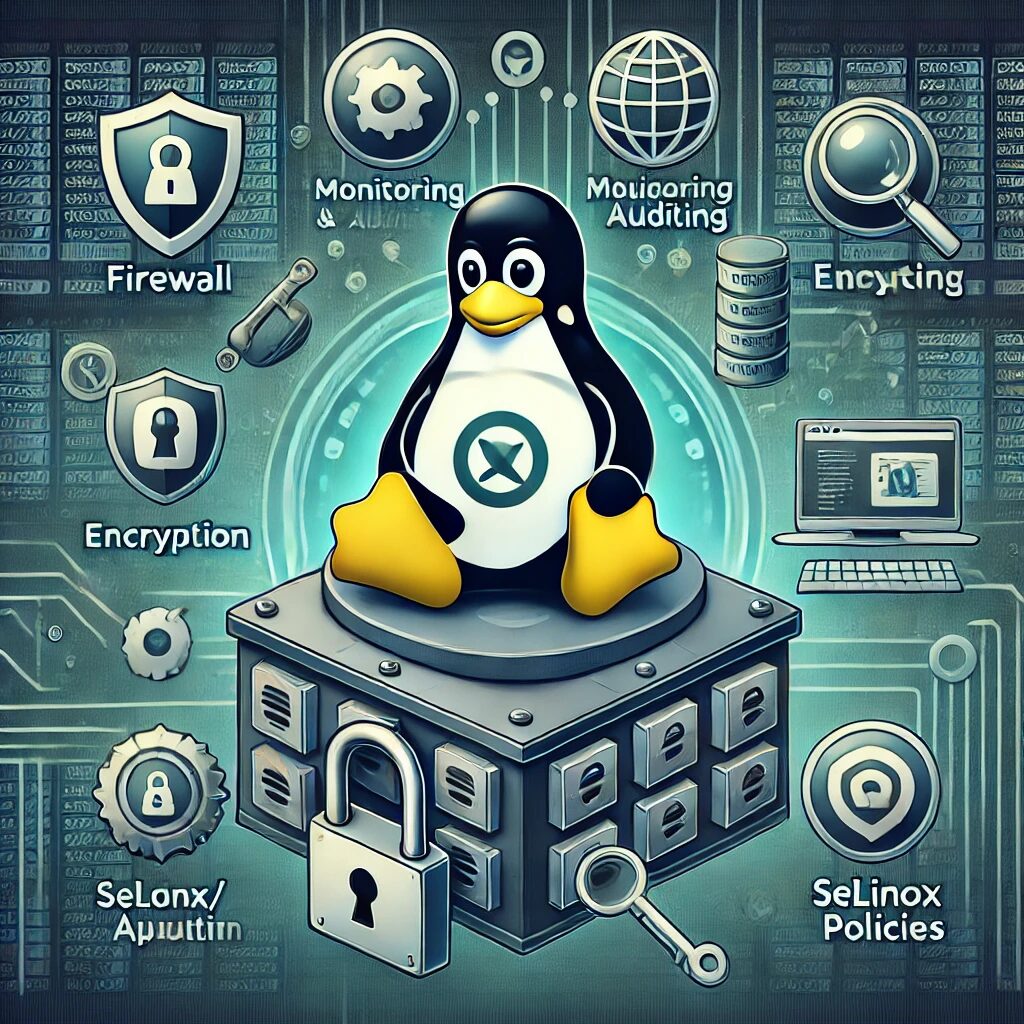A Guide
Linux, widely known for its flexibility, performance, and open-source nature, powers everything from small devices to large-scale enterprise systems. However, like any operating system, Linux is susceptible to security threats. This article explores the essential security practices and measures needed to protect Linux-based systems from a wide variety of vulnerabilities and attacks.
1. The Linux Security Model
Linux’s security model is built on the core principles of user roles, permissions, and the least privilege model. Key components of Linux security include:
- User Accounts and Permissions: Every file and process in Linux is owned by a user and a group, with permission levels set for each (read, write, execute). By ensuring that users only have the permissions they need, Linux enforces the principle of least privilege.
- Root User: The
rootuser (also known as the superuser) has complete access to the system. This account should be protected and only used when necessary to avoid accidental or malicious system changes.
2. Essential Linux Security Measures
A. Hardening the Operating System
Securing a Linux-based system starts with hardening the OS itself. This involves reducing the attack surface by disabling unnecessary services and ensuring that the system is up to date. Here are some key techniques:
- Package Updates: Keep all software packages up to date. Linux distributions like Ubuntu, Debian, and Fedora have package managers (
apt,dnf, etc.) that make it easy to update software and security patches.
sudo apt update && sudo apt upgrade -y- Minimize Software Installation: Install only the software necessary for your use case. The fewer services running, the fewer vulnerabilities that can be exploited.
- Disable Unnecessary Services: Use tools like
systemctlto stop and disable services that aren’t required. Unnecessary services can be exploited by attackers.
sudo systemctl disable [service_name]- File Integrity Monitoring: Tools like
AIDE(Advanced Intrusion Detection Environment) monitor changes to critical system files and directories, alerting administrators when unauthorized changes occur.
B. Security Policies and Configuration
- SELinux and AppArmor: Linux includes Mandatory Access Control (MAC) systems like SELinux (Security-Enhanced Linux) and AppArmor. These tools limit the access processes have to files, thus reducing potential damage if a process is compromised.
- SELinux enforces security policies that define what each user, process, and file can do. It’s often found in Red Hat-based distributions like CentOS and Fedora.
- AppArmor, popular in Ubuntu, allows administrators to define access policies for individual programs.
- Firewall Configuration: Use firewalls to manage incoming and outgoing traffic on the system. The most commonly used firewall on Linux is
iptablesor its modern replacementnftables. Tools likeufw(Uncomplicated Firewall) provide a simplified interface for configuring firewall rules.
sudo ufw allow 22/tcp # Allow SSH traffic
sudo ufw enable- Password Policies: Use strong password policies with tools like
pam_pwqualityto enforce minimum password lengths, complexity requirements, and password expiration.
sudo nano /etc/security/pwquality.conf- Two-Factor Authentication (2FA): Implement 2FA for added protection. Tools like
Google Authenticatororlibpam-google-authenticatorcan add an extra layer of security.
C. Network Security
Network security is crucial in preventing unauthorized access to a Linux system, especially in enterprise or cloud environments.
- SSH Hardening: Secure Shell (SSH) is commonly used for remote access to Linux systems, and it’s a primary target for attackers. To harden SSH:
- Disable Root Login: Root login should be disabled over SSH. This forces attackers to compromise a non-privileged account first.
sudo nano /etc/ssh/sshd_config PermitRootLogin no - Use SSH Keys: SSH key authentication is far more secure than password-based authentication. Generate an SSH key pair and disable password authentication.
sudo nano /etc/ssh/sshd_config PasswordAuthentication no - Use Non-Default Ports: Change the default SSH port (22) to reduce the risk of brute-force attacks.
sudo nano /etc/ssh/sshd_config Port 2200 - Network Traffic Encryption: Use tools like
OpenVPNorWireGuardto encrypt network traffic, ensuring secure remote access to Linux servers.
D. Monitoring and Logging
Vigilant monitoring and logging can help detect security incidents early and mitigate their impact.
- System Logs: Linux logs events using
rsyslogorjournalctl. Regularly review these logs for suspicious activity, and use log monitoring tools likeLogwatchorGraylogfor more comprehensive analysis. - Intrusion Detection Systems (IDS): Use IDS tools like
SnortorOSSECto detect potential intrusions by monitoring network traffic and system behavior. - Auditd: The
auditdservice records a comprehensive set of system events, allowing administrators to track changes to important files and configurations.
sudo apt install auditd
sudo auditctl -w /etc/passwd -p wa3. Container and Virtualization Security
Containerization and virtualization introduce unique security challenges, but also offer additional isolation. Best practices include:
- Docker Security: When using Docker, ensure that images are from trusted sources. Use security features like
seccomp,AppArmor, orSELinuxto sandbox containerized applications. - LXC/LXD Security: If you’re using Linux containers (LXC or LXD), enable user namespaces to isolate container privileges from the host system.
- VM Isolation: For virtual machines, use hardware-supported security features such as Intel VT-x and AMD-V, and keep hypervisor software (e.g., KVM, QEMU) up to date.
4. Protecting Data and User Privacy
Data privacy and protection are paramount in any security strategy. Encrypting sensitive data and protecting user information help to safeguard against breaches.
- Disk Encryption: Use full disk encryption with tools like
LUKS(Linux Unified Key Setup) to protect sensitive data in the event of hardware theft or loss.
sudo cryptsetup luksFormat /dev/sda1
sudo cryptsetup luksOpen /dev/sda1 secure_disk- Encrypted File Systems: Tools like
eCryptfsorEncFScan be used to encrypt individual directories or files, adding an extra layer of protection. - Secure Backups: Implement automated backups using tools like
rsync,Duplicati, orBacula, and store backups in secure, encrypted locations.
5. Responding to Incidents and Vulnerabilities
No security measure is foolproof, and responding to incidents quickly is essential. Linux administrators should:
- Use CVE Databases: Monitor the Common Vulnerabilities and Exposures (CVE) database for known vulnerabilities in the software stack you use.
- Patching Vulnerabilities: Ensure timely patching of known vulnerabilities using package managers and security advisories from your Linux distribution.
- Incident Response Plan: Have a documented incident response plan to address breaches or attacks. This should include isolating compromised systems, restoring from backups, and conducting post-incident reviews.
6. Final Thoughts
Linux is a robust and secure platform, but it requires active management to defend against evolving security threats. By implementing these security practices and continuously monitoring and updating systems, administrators can significantly reduce the risk of compromise and safeguard their Linux-based infrastructure.
Securing Linux is not a one-time task, but an ongoing process that adapts to new threats and vulnerabilities. Stay informed, keep your systems updated, and implement security policies to ensure long-term protection.
7. Additional Resources
Here are some valuable resources to deepen your understanding of Linux security:
- The Linux Security Expert – A comprehensive guide covering a wide range of Linux security topics, tools, and best practices. Linux Security Expert
- The Linux Foundation: Security Best Practices for Linux – Offers extensive documentation and resources on Linux security, including open-source tools and security certifications. The Linux Foundation – Security
- Red Hat Security Guide – Detailed guidance from Red Hat on securing enterprise Linux systems, including SELinux and firewalls. Red Hat Security Guide
- Debian Security FAQ – A practical guide on keeping Debian systems secure with an overview of patches, updates, and configurations. Debian Security FAQ
- Ubuntu Security Team Wiki – Offers documentation and best practices on securing Ubuntu, including AppArmor, updates, and vulnerability response. Ubuntu Security Wiki
- Arch Linux Security Guide – Focuses on securing Arch Linux installations, from firewalls to user management. Arch Linux Security Guide
- SELinux Project – The official website for SELinux, providing extensive documentation, tutorials, and policy examples. SELinux Project
- OWASP Linux Security Guide – From the Open Web Application Security Project, this guide covers Linux server security basics. OWASP Linux Security Guide
- LXD and Linux Containers Security – A guide by Canonical on securing LXD containers, which are often used for lightweight virtualization. Linux Containers Security
- Security Stack Exchange – A forum where you can ask questions and find detailed answers related to Linux security. Security Stack Exchange: Linux Security
These resources offer an excellent mix of tutorials, guides, and community-driven knowledge on securing Linux systems.


